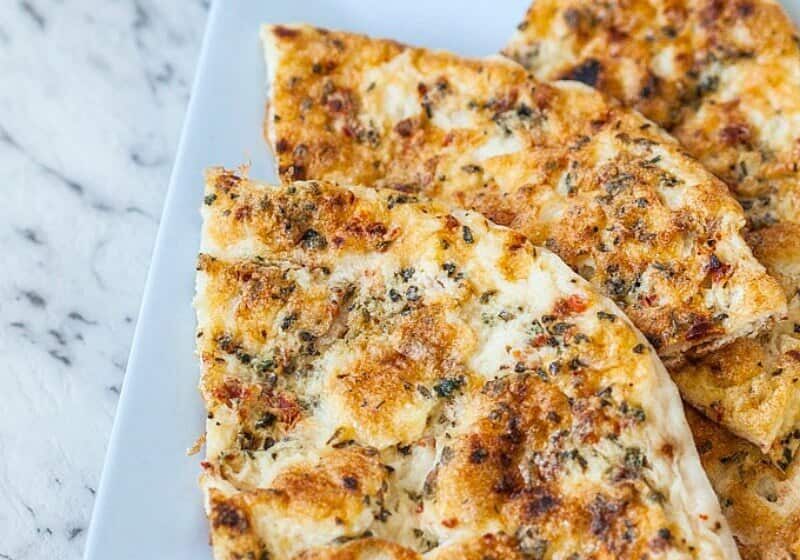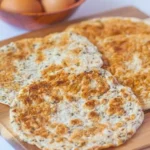A really, really easy to make Keto bread for when you need bread fast! Cook a little longer for pizza base or crackers.
Keto Flatbread (5 ingredients!)
This keto flatbread recipe needs just 3 ingredients to make and no yeast! Perfect for wraps, sandwiches and pizza crusts, this keto flatbread takes minutes to make!
Servings: 4
Cost: £6
Ingredients
- 60 g almond flour
- 30 g coconut flour
- 2 teaspoon baking powder (level teaspoons)
- 12 large egg whites can use cartoned egg whites
- 1 teaspoon spices of choice salt, pepper, onion powder, garlic powder etc.
Instructions
- In a large mixing bowl, combine the egg whites, coconut flour, baking powder, salt and any other spices and whisk immediately to avoid clumping. Set aside.
- Coat a large frying pan with oil and on low heat, allow to heat up completely. Once hot, pour 1/4 of the mixture into the pan and cover immediately. Once bubbles start to appear on the edges, remove cover and flip and cook for 1-2 minutes. Repeat the process until you have four, large flatbreads.
- Allow to cool completely before using.
- In a large mixing bowl, combine the egg whites, coconut flour, almond flour, baking powder, salt, and any other spices.
- Whisk immediately and thoroughly to avoid clumping and to ensure all dry ingredients are fully incorporated into the egg whites. The batter should be smooth. Set aside.
- Coat a large non-stick frying pan (about 20-25 cm in diameter) with a light layer of oil and place it over low to medium-low heat. Allow the pan to heat up completely – this is crucial for even cooking.
- Once the pan is hot, pour 1/4 of the mixture (approximately 75 ml of batter) into the pan. Immediately cover the pan with a lid.
- Cook for approximately 3-5 minutes, or until bubbles start to appear all over the surface and the edges look set and slightly opaque. The top should appear mostly cooked through.
- Carefully remove the cover and flip the flatbread. Cook for another 1-2 minutes on the second side, or until golden brown and cooked through.
- Transfer the cooked flatbread to a wire rack to cool completely. This allows any steam to escape and prevents sogginess.
- Repeat the process with the remaining batter until you have four large flatbreads.
- Allow to cool completely before using.
Notes
Nutrition Info:
Estimated Nutritional Information Per Flatbread (Divide by 4, excluding cooking oil):Calories: ~178 - 191 kcal
Total Carbohydrates: ~9.7 g
Dietary Fiber: ~4.9 g
Net Carbohydrates: ~4.8 g
Protein: ~16.7 g
Total Fat: ~8.7 g
- Net Carbs: At approximately 4.8g per flatbread, these fit well within most ketogenic dietary guidelines (typically aiming for under 20-50g net carbs per day).
- Protein: These flatbreads are a good source of protein, which is important for satiety and muscle maintenance.
- Fiber: The coconut and almond flour contribute a decent amount of fiber, which is beneficial for digestive health on a low-carb diet.
- Fat: The fat content comes primarily from the almond flour and any added cooking oil.
Tips for Ensuring Even Cooking Consistency (Remain the same)
Achieving uniform flatbreads can be tricky, but these tips will help:- Precise Heat Management: This is the most critical factor. Use low to medium-low heat and be patient. If the heat is too high, the outside will burn before the inside cooks through. If it's too low, the flatbreads might not brown properly and could become tough. Take the time to preheat your pan thoroughly.
- Non-Stick Pan is Key: A good quality non-stick frying pan will prevent sticking and allow for easier flipping without tearing the delicate flatbreads.
- Consistent Batter Consistency: Ensure your batter is smooth and lump-free. Lumps of dry flour will result in uncooked spots. Whisk well and don't be afraid to give it another quick whisk before pouring each flatbread if it has been sitting for a while.
- Even Pouring: Try to pour the same amount of batter for each flatbread. You can use a measuring cup (e.g., 75 ml) to help with this. As you pour, gently tilt the pan to spread the batter evenly into a circle.
- Covering the Pan: Covering the pan traps steam, which helps to cook the flatbread from the top and ensures it cooks through evenly without drying out. It's especially helpful for thicker flatbreads.
- Look for Visual Cues: Don't just rely on time. Watch for bubbles appearing on the surface and the edges looking set and opaque before flipping. These are good indicators that the first side is cooked.
- Cooling Completely: Allowing the flatbreads to cool completely on a wire rack is essential. This prevents them from becoming soggy due to trapped steam and helps them firm up, making them easier to handle.
- Adjusting Cook Time: Cooking times are approximate. Your stove and pan will vary. After the first flatbread, you'll get a better feel for the ideal cooking time on each side. Adjust accordingly for subsequent flatbreads.



